陳宜誠律師,東吳法學碩士/台大電機碩士
| 要判斷一項專利是否具有「進步性」是很複雜的,為避免產生「後見之明」的偏差,智財局或法院不妨參照美國司法所揭示的判斷標準與闡明,在判決時更要提供「一般常識」或「背景知識」的佐證資料,擁有明確論述與佐證資料的判決,不但能服人也可避免無謂紛爭。 |
大家都知道一個技術上的創新發明,若要申請到專利,就要通過專利局對於其之利用性、新穎性與進步性,所謂「專利三性」的審查。發明的「利用性」,指的是該等技術可以量產,而能為社會大眾所利用。而其「新穎性」,是指其技術內涵中,有不屬於已經存在的技術(又稱先前技術),或已經揭露的技術內容(註1),也就是說,該發明含有新的技術內容,而發明人揭露其給社會大眾知曉,社會大眾由不知到知,而有所得,專利局似乎就應代表大眾授予申請人專利證書,以為回報。
但並非對既有技術有所突破,與之有所不同的「新」發明(即具備「新穎性」,Novelty),都能取得專利權的保護,該發明還必須該發明和既有技術相比較,有達到一定之進步程度,即具備「進步性」,才能得到專利權的保護(註2)。否則,任何人對於既有技術做出小幅的調校或簡易置換,若就可以得到專利權的保護,而能壟斷市場專有其利益至少十餘年,顯非妥適之舉。而此「進步性」的判斷,在歐洲稱之為「創造性」(Inventive Step),在美國稱之為「非顯而易知性」(Non-Obviousness)。
非顯而易見性(即進步性)的審查,有可能於專利局(申請時與被舉發時)與法院(獲證後)進行,但因為其包含了(1)先前技術(Prior-Art)、(2)熟習該發明所屬技術領域之通常知識者、(3)非顯而易知(即我國審查基準所謂的「所能輕易完成」)等因素的判斷,由於這些因素很難有一個客觀的定義,所以在專利審查與複審的過程中,一直是一個較具爭議的階段。
美國司法採用判例法則(Case Law),美國法院藉由個案的審理與判決,揭示了各類判斷非顯而易知性之原則與測試法則,對非顯而易知性提供了判斷的標準,包括了Graham案所揭示之判斷法則,TSM教示測試法則,以及KSR 案所闡示之判斷標準等。以下筆者就這些美國聯邦法院判例,以及美國專利商標局(USPTO)依據該等判例,修訂其對於非顯而易見性(即進步性)的審查基準要項,做一簡要的介紹,以饗有興趣一窺究竟的讀者。
| 北美智權公司近期亦將針對一般發明人與研發人員,推出一系列的「專利基礎」、「迴避設計」、「保護技巧」與「研發創新」等多門線上課程,以深入淺出並配以實例講解的方式,來教導各位發明人,從認識專利開始,進而活用專利,再來創造更多的專利,取得事業的成功。完成該等教育訓練學程後,學員能由解決實際工作中所碰到的問題開始,進行系統化的技術研發與創新,還能借鏡他人並放大既有成功經驗,更可以專利等智財保護方式,將該等發明創見保護好,並進行全球專利布局,以獲取最大商業利益,敬請期待。 |
Greenwood 案-非顯而易知性
在西元(下同)1850年的Hotchkiss vs. Greenwood, 52 U.S. 248 –(1850)案(下稱Greenwood案)中,Hotchkiss、Davenport與Quincy先生將一個陶土做的門把(clay doorknob)申請了專利並獲證。
圖一、Hotchkiss、Davenport與Quincy的專利
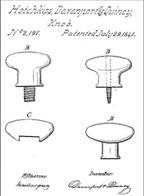
圖片來源:USPTO

圖片來源:USPTO
Greenwood先生也製造了類似的門把,而被Hotchkiss等三人控告侵權。Greenwood先生抗辯說,Hotchkiss等人的專利應該無效,因為他們的發明是顯而易見的(not non obvious),早就有很多人用陶土來燒製把手,而一般的門把是金屬或木頭製的,Hotchkiss等人只是把陶土用在標準的門把製造程序而已。
美國聯邦最高法院在該Greenwood案判決認為,「僅簡易置換所用材料為另一已知材料,而沒有超越一般熟習該等技術普通智識人士的技術能力與智能所得,是不能被專利的」(”the mere substitution of one known material for another without some technical skill and ingenuity beyond that possessed by an ordinary mechanic acquainted with the business is not patentable”),而創設了此一非顯而易見性的判準,判決Greenwood勝訴,而該Hotchkiss等人的專利無效(註3)。
Graham案-判斷要素
1952年美國專利法第103條就將上述判例納入法律明文,規定一件發明為了要能獲准專利必須要是非顯而易知的(Non-Obvious)。也就是說,就整體觀之在發明完成時,發明與先前技術間之差異對於習知技藝人士必須是非顯而易知的。但是,這時法院還沒有提出比較具體的進步性判斷操作標準(測試法則,Test),以供大眾自我檢測,以求滿足法院判決結果的可預測性。
美國司法藉由判例,提供大眾這些測試法則的原因是,如果大家在上法院爭訟前,就能明瞭法院的判斷標準,也能自行操作測試法則,合理預測其勝訴或敗訴的可能,那麼原告除非穩握勝券,否則不會輕易提訴;而被告發現敗訴可能性很大,或者上訴翻盤的機率實在不高,也會儘速與對方和解撤訴,這樣就能快速達到法院息訟止紛的效果,並建立司法判決的權威性。
在1966年Graham v. John Deere, 383 US 1, 17-18, 148 USPQ 459, 467案(下稱Graham案)判決中,美國聯邦最高法院就提供了如此的一個測試法則。
Graham先生申請了兩個與「犁柄安裝系統」(plow shanks mounting system)有關的專利,各於1950年(如圖二)與1953年(如圖三)獲證。
圖二、Graham的第1個專利
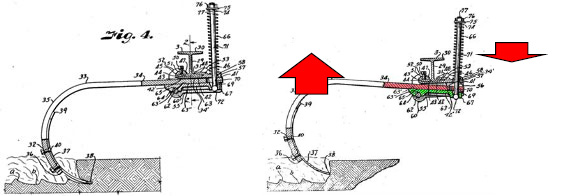

圖三、Graham的第2個專利

圖片來源:USPTO

圖片來源:USPTO
Graham先生提告John Deere公司所生產的耕作機具,因侵害其第二個專利而侵權。而John Deere抗辯說,Graham先生專利所揭露的技術內容不符合非顯而易知性,應該無效。John Deer則主張說,Graham的第二個專利,熟習該類技術者應該可以由先前技術(1951年申請之「倫科夾」“Glencoe clamp” 專利,如圖四)與Graham的第一個專利,輕易組合而得,並無進步性。
圖四、「倫科夾」“Glencoe clamp” 專利
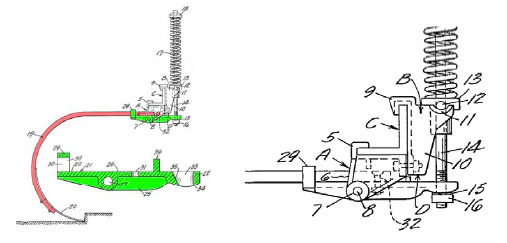
圖片來源:USPTO

圖片來源:USPTO
美國最高法院該Graham案判決中,確認美國聯邦第8巡迴上訴法院John Deere 勝訴判決,並認定Graham先生的第二個專利為無效,就藉此案創設了審查非顯而易知性的幾個判斷要素(factors),為爾後法院進行非顯而易知性判斷的操作標準︰
- 決定先前技術之範圍及內容;
- 確認先前技術與申請專利範圍之差異;
- 確定申請專利之發明所屬技術領域中具有通常知識者之技術水準;
- 評估做出「輔助性判斷因素」(secondary consideration)之證據。
此即成為美國法院實務用來確認與決定美國專利法§103條(a)項非顯而易知性之所謂「Graham要素」判斷法則(註4)。其中所謂「輔助性判斷因素」(secondary consideration),有翻譯成「第二層考量」或「次要考量因素」者,係指發明雖係先前技術的簡易組合,但例外具有進步性(非顯而易知)的情況,例如結果具有原來大家都無法預期的功效,或者克服了技術偏見(業界從來都不認為往這技術發展方向繼續進行,能夠解決問題)(註5)。
美國CAFC之TSM標準
然而,由於大部分的發明都是基於先前技術的改良,因此法院對於申請專利之發明所屬技術領域中具有通常知識者,申請當時會不會或能不能也輕易做出同樣發明的判斷,常常容易落入所謂的「後見之明」而否定了發明的非顯而易知性。1982年美國國會通過法源,正式設立「聯邦巡迴上訴法院」(Court of Appeals for Federal Circuit;簡稱CAFC),其理由之一,就是要將不同法院對待專利的標準趨於全國一致性。
因此,CAFC就創設了「教示、建議及動機」檢測法(Teaching, Suggestion, or Motivation, 簡稱TSM),試圖釐清何謂「非顯而易知」並用來防止後見之明,長期以來已為USPTO審查先前技術中,已知元件之組合是否符合專利法第103條(a)非顯而易知性之分析方法。
根據此TSM測試方法,美國專利法第 103 條所規範的顯而易知性,
- 是以結合或修改兩篇或兩篇以上的引證文件為核駁的基礎,而且引證文件會如此結合或修改的理由必須來自於引證文件本身的教示,或具有一般技藝之人士的知識所提供的教示、還有屬於暗示或隱喻的建議或動機(即TSM)(註6),而該等動機的來源有三:(1)發明所欲解決的問題特性;(2)先前技術的教示內容;以及(3)具有該發明所屬技術領域之通常知識者的知識,惟在此需注意的是,具有發明所屬技術領域之通常知識者,欲結合或修改引證文件的動機,可以不同於發明人的動機。
- 習於該項技藝者可合理預期如此做會成功(註7)。
- 先前技術或其組合必須有教示、建議或產生動機,以使習於該項技藝者會如此組合成符合該請求項所有的技術特徵之產品,而這些將先前技術組合成如請求項的技術特徵,以及如此做可得到合理預期成功之「教示、建議或動機」,僅限於可於先前技術中找到者,而不是來自專利申請者自己的揭露(註8)。
另依據不可專利之表面證據情況原則,若審查人員據以核駁的兩篇或兩篇以上的引證文件,無法證明申請專利範圍所載發明是顯而易知的—亦即審查人員未成功建立顯而易見性之表面證據情況,則應核准該申請專利範圍。故顯而易知性核駁的答辯重點,主要在於爭辯兩篇或兩篇以上的引證文件,並無法或無「教示/建議/動機」如審查人員所稱加以結合,應該核准其專利(註9)。
KSR案判決重點
美國聯邦最高法院在 KSR v. TELEFLEX (No. 04-1350) 案(下稱KSR案)的判例中,加強闡述此「顯而易見」(Obviousness)的測試規則。美國最高法院於該KSR案判決中,認為CAFC僅專依此TSM測試為據,導致以往申請人太容易獲得專利,也被過度保護,許多專利只是改良或組合舊技術,不能算是真正創新。判決文指出︰「以一般方法而非真正創新方法獲得進步的技術,若獲得專利權保護,只會阻礙進步,而專利若結合以前已知的元件,則可能剝奪發明的價值或效用。」
Teleflex公司擁有一個關於「可調[氣]踏板總成電子油門控制」(Adjustable [gas] pedal assembly with electronic throttle control)的專利(US6237565),當KSR公司將一電子感測器加入其所生產之踏板構件時,Teleflex公司即提告KSR公司侵害其專利。
圖五、Teleflex的踏板構件專利(US 6,237,565)
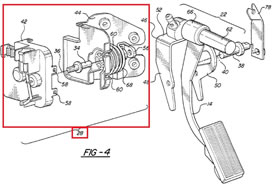
圖片來源:USPTO

圖片來源:USPTO
圖六、Teleflex的專利請求項4
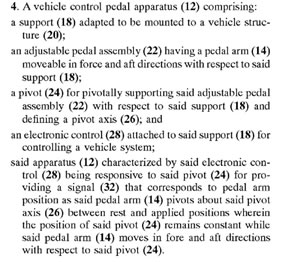
圖片來源:USPTO

圖片來源:USPTO
而KSR公司則提出以下的先前技術,抗辯說將其組合即可得到Teleflex公司的專利,因此其為顯而易見而無效。
- Asano/淺野(可調踏板與固定支點)
- RIXON(可調整踏板與踏板傳感器)
- Smith/史密斯(在踏板的固定部件的傳感器)
美國聯邦地院判決Teleflex的專利為顯而易見而無效,Teleflex公司上訴CAFC,CAFC認為地院採用過於寬鬆的標準來認定何謂「教示/建議/動機」,裁定這些前案對於習於該項技術類別者並非唾手可得,也未曾用於解決所述的問題,因此「即使『明顯值得一試』,仍然不構成顯而易知」(even if it was “obvious to try”, this did not constitute obviousness)而推翻地院的判決,維持Teleflex的專利為有效,KSR公司隨即上訴美國聯邦最高法院。美國聯邦最高法院做出一致判決,認為CAFC 過份嚴格進行TSM的判斷,而推翻CAFC的判決並發回更審。
美國聯邦最高法院在本KSR案判決中認為,除CAFC以往所認可的「先前技術」、「問題本質」或「通常知識」必須有明示(有跡可循)的「教示、建議及動機(TSM)」外,該法院進一步認為,發明時所有領域或該專利中所載任何已知之需求或問題,均得作為將技術組合之理由。
美國聯邦最高法院在該KSR案判決文中指出︰「在決定專利標的是否為顯而易知時,並非取決於專利權人的特殊動機或其宣稱的用途。重要的是該申請專利範圍客觀上所要達到的目的。若該申請專利範圍延伸至顯而易知的程度,則該申請專利範圍違反§103而為無效。得證明申請標的係為顯而易知的方式之一,係指出在發明當時存在一已知問題,而對該問題顯而易知的解決方式即包含在申請專利範圍之內…在正確的分析下,在發明當時,任何存在於該努力的領域且為該專利所欲解決之已知需求及問題者,可以作為請求項中該等元件之組合的理由…已知技術也可能有超出其主要目的之外的其他顯而易知用途,該發明所屬技術領域中具有通常知識者藉普通常識(common sense)往往能像拼圖一樣,將複數個專利之教示組合起來。…決定專利請求項中已知元件之組合的理由,通常須視複數個專利之間相互關聯的教示;設計業者已知或市場上已呈現之需求;及該發明所屬技術領域中具有通常知識者之背景知識。」不論先前技術所針對的問題為何,「當欲解決之問題有設計需求或市場壓力,而且被認知到可預期之解決方案的數目有限時,該發明所屬技術領域中具有通常知識者在可掌握的技術範圍內有理由去完成該已知的選擇。若其可導致預期的成功,則該成品可能不具有開創性而僅為一般技術或普通常識。在這種情況下,組合係「明顯可試」(obvious to try)的事實可能,顯示其為顯而易知而違反§103(註10)。
綜上,大法官們認為CAFC上訴法院對於發明是否顯而易知的觀點過於狹隘與僵化,與專利法以及最高法院先例不符合。而大法官們也重申40年前Graham案所定下的分析框架,並特別就組合專利型的發明闡釋非顯而易知的意涵,對於CAFC發展出的TSM測試中所包含的一般性原則,實際上是加以肯定其用心良苦,不過訓誡千萬不要將這些一般性的原則轉變為一種僵化的公式而限制了發明是否顯而易知的詢問廣度,並且具體剖析於CAFC在本案中對於TSM測試之適用缺失何在(註11)。
但筆者認為此判例在日後的實際應用上,這KSR案判例可能會製造許多衍生問題,特別是來自於下列兩大範疇:
- 「一般常識」(common sense)的應用;
- 「背景知識」(background knowledge)的實際應用。
以此KSR案為例,美國最高法院強調習知技藝者於該「是否顯而易見」的分析中,是可允許使用「一般常識」和「背景知識」,作為辨別是否擁有足夠明顯的理由以組合其所提供的若干引證案,以構成某專利請求項之正當依據(“apparent reason to combine the known elements in the way a patent claims”)。該KSR 判例是這樣敘述的:「… 然而,對於某些熟悉與常見的普通項目,除了它們原本的使用目的以外,一般常識也會教導明顯的使用方法。因此,具有習知技藝者不會只受到前述的先前技術的引導而已…」。
由於此KSR案判例,允許法院使用該發明所屬技術領域中具有通常知識者所具有之「一般常識」和「背景知識」,來判斷其是否有足夠明顯理由去組合先前技術的技術特徵,以構成專利請求項,亦即判斷該等組合行為是否屬於「明顯可試」(obvious to try),以辨別該發明是否具備進步性(非顯而易知性),美國媒體多認為從此以後:
- USPTO更容易以非顯而易知性核駁申請案;
- 再審查案更容易被USPTO審定專利無效;
- 專利侵權訴訟程序中,被告更容易舉證證明專利無效。
2007年美國專利審查手冊之修定
針對該KSR案美國最高法院判決,美國專利商標局(USPTO)於2007年修訂的美國專利審查手冊(Manual of Patent Examining Procedure),就指示審查人員在審查「顯而易知性」時,應依據下列七項具有可操作性的規則,來考慮幾個先前技術是否可以被顯而易見地組合在一起(註12):
判斷顯而易見性的基本規則 (Obviousness Rationales)
- 用已知的方法將前案的元件結合,產生可以預期的結果(註13)。
- 將一個已知的元件單純地用另一個元件替代,而獲得可以預期的結果(註14)。
- 用已知的技術以相同的方式去改善類似的裝置(方法或產品)(註15)。
- 用已知的技術去改善一個已知而且待改善的裝置(方法或產品),而產生可預期的結果(註16)。
- 「明顯可試」(Obvious to try):從有限的幾個已經被指認出來而且是可以預期的方法中加以選擇,而且可以合理的預期會得到成功的結果(註17)。
- 在某一領域中的已知成果,有可能會在相同或其他領域中,基於它在設計上的優點或它所引起的市場需求,而產生相類似的變化,如果這種變化對於該領域的習知技藝者來說是可被預期的(註18)。
- 當習知技藝者依據某一先前技術所揭示的教導、建議或動機(TSM),去修改另一先前技術或將幾個先前技術組合在一起,從而得到專利範圍中所申請的發明(註19)。
這邊很重要的是,美國專利商標局仍然以TSM「明確」的教示/建議/動機原則,要求審查員,若依據非顯而易見性的規定而核駁時,必須提供佐證文件,不能輕易以所謂一般常識或背景資料為顯而易知而核駁之。新增可引用一般常識與與背景知識的情況,僅限於第5款「明顯可試之解決方案」與第6款的「複製他領域成功經驗」,且都強調其應為習知技藝者「可合理預期」的變化或結果。
2010年公告新版顯而易見性審查指南
上述之2007年版的專利審查指南內容,現已併入MPEP第2143、2144兩節。而如前期文章《USPTO公告新版顯而易見性審查指南(上)》及《USPTO公告新版顯而易見性審查指南(下)》所詳述,美國專利商標局2010年9月1日又公告了新版顯而易見性審查指南(2010 KSR Guidelines Update,PDF),但基本上仍根據2007公佈的7項審查基本規則,並無更動。
但該新版指南又整理出20件判例,分別用以說明前述基本規則第1、2、5項參考指標的運用方式。另外也篩選4件判例,說明相關證據的考慮與運用原則,例如因為輔助性判斷因素而例外具有非顯而易見性,如下所示。
顯而易見的嘗試
相關證據考慮原則
但該新版指南又整理出20件判例,分別用以說明前述基本規則第1、2、5項參考指標的運用方式。另外也篩選4件判例,說明相關證據的考慮與運用原則,例如因為輔助性判斷因素而例外具有非顯而易見性,如下所示。
- 先前技術元件的組合
判例
|
教示重點
|
英文原文
| |
| In re Omeprazole Patent Litigation | Even where a general method that could have been applied to make the claimed product was known and within the level of skill of the ordinary artisan, the claim may nevertheless be nonobvious if the problem which had suggested use of the method had been previously unknown. |
| Crocs, Inc. v. U.S. Int'l Trade Comm'n. | A claimed combination of prior art elements may be nonobvious where the prior art teaches away from the claimed combination and the combination yields more than predictable results. |
| Sundance, Inc. v. DeMonte Fabricating Ltd. | A claimed invention is likely to be obvious if it is a combination of known prior art elements that would reasonably have been expected to maintain their respective properties or functions after they have been combined. |
| Ecolab, Inc. v. FMC Corp. | A combination of known elements would have been prima facie obvious if an ordinarily skilled artisan would have recognized an apparent reason to combine those elements and would have known how to do so. |
| Wyers v. Master Lock Co. | The scope of analogous art is to be construed broadly and includes references that are reasonably pertinent to the problem that the inventor was trying to solve. Common sense may be used to support a legal conclusion of obviousness so long as it is explained with sufficient reasoning. |
| DePuy Spine, Inc. v. Medtronic Sofamor Danek, Inc. | Predictability as discussed in KSR encompasses the expectation that prior art elements are capable of being combined, as well as the expectation that the combination would have worked for its intended purpose. An inference that a claimed combination would not have been obvious is especially strong where the prior art's teachings undermine the very reason being proffered as to why a person of ordinary skill would have combined the known elements. |
- 習知元件的簡單置換
判例
|
教示重點
|
英文原文
| |
| In re ICON Health & Fitness, Inc. | When determining whether a reference in a different field of endeavor may be used to support a case of obviousness (i.e., is analogous), it is necessary to consider the problem to be solved. |
| Agrizap, Inc. v. Woodstream Corp. | Analogous art is not limited to references in the field of endeavor of the invention, but also includes references that would have been recognized by those of ordinary skill in the art as useful for applicant's purpose. |
| Muniauction, Inc. v. Thomson Corp. | Because Internet and Web browser technologies had become commonplace for communicating and displaying information, it would have been obvious to adapt existing processes to incorporate them for those functions. |
| Aventis Pharma Deutschland v. Lupin, Ltd. | A chemical compound would have been obvious over a mixture containing that compound as well as other compounds where it was known or the skilled artisan had reason to believe that some desirable property of the mixture was derived in whole or in part from the claimed compound, and separating the claimed compound from the mixture was routine in the art. |
| Eisai Co. Ltd. v. Dr. Reddy's Labs., Ltd. | A claimed compound would not have been obvious where there was no reason to modify the closest prior art lead compound to obtain the claimed compound and the prior art taught that modifying the lead compound would destroy its advantageous property. Any known compound may serve as a lead compound when there is some reason for starting with that lead compound and modifying it to obtain the claimed compound. |
| Procter & Gamble Co. v. Teva Pharmaceuticals USA, Inc. | It is not necessary to select a single compound as a "lead compound" in order to support an obviousness rejection. However, where there was reason to select and modify the lead compound to obtain the claimed compound, but no reasonable expectation of success, the claimed compound would not have been obvious. |
| Altana Pharma AG v. Teva Pharms. USA, Inc. | Obviousness of a chemical compound in view of its structural similarity to a prior art compound may be shown by identifying some line of reasoning that would have led one of ordinary skill in the art to select and modify a prior art lead compound in a particular way to produce the claimed compound. It is not necessary for the reasoning to be explicitly found in the prior art of record, nor is it necessary for the prior art to point to only a single lead compound. |
判例
|
教示重點
|
英文原文
| |
| In re Kubin | A claimed polynucleotide would have been obvious over the known protein that it encodes where the skilled artisan would have had a reasonable expectation of success in deriving the claimed polynucleotide using standard biochemical techniques, and the skilled artisan would have had a reason to try to isolate the claimed polynucleotide. KSR applies to all technologies, rather than just the "predictable" arts. |
| Takeda Chem. Indus. v. Alphapharm Pty., Ltd. | A claimed compound would not have been obvious where it was not obvious to try to obtain it from a broad range of compounds, any one of which could have been selected as the lead compound for further investigation, and the prior art taught away from using a particular lead compound, and there was no predictability or reasonable expectation of success in making the particular modifications necessary to transform the lead compound into the claimed compound. |
| Ortho-McNeil Pharmaceutical, Inc. v. Mylan Labs, Inc. | Where the claimed anti-convulsant drug had been discovered somewhat serendipitously in the course of research aimed at finding a new anti-diabetic drug, it would not have been obvious to try to obtain a claimed compound where the prior art did not present a finite and easily traversed number of potential starting compounds, and there was no apparent reason for selecting a particular starting compound from among a number of unpredictable alternatives. |
| Bayer Schering Pharma A.G. v. Barr Labs., Inc. | A claimed compound would have been obvious where it was obvious to try to obtain it from a finite and easily traversed number of options that was narrowed down from a larger set of possibilities by the prior art, and the outcome of obtaining the claimed compound was reasonably predictable. |
| Sanofi- Synthelabo v. Apotex, Inc. | A claimed isolated stereoisomer would not have been obvious where the claimed stereoisomer exhibits unexpectedly strong therapeutic advantages over the prior art racemic mixture without the correspondingly expected toxicity, and the resulting properties of the enantiomers separated from the racemic mixture were unpredictable. |
| Rolls-Royce, PLC v. United Technologies Corp. | An obvious to try rationale may be proper when the possible options for solving a problem were known and finite. However, if the possible options were not either known or finite, then an obvious to try rationale cannot be used to support a conclusion of obviousness. |
| Perfect Web Techs., Inc. v. InfoUSA, Inc. | Where there were a finite number of identified, predictable solutions and there is no evidence of unexpected results, an obvious to try inquiry may properly lead to a legal conclusion of obviousness. Common sense may be used to support a legal conclusion of obviousness so long as it is explained with sufficient reasoning. |
判例
|
教示重點
|
英文原文
| |
| PharmaStem Therapeutics, Inc. v. ViaCell, Inc. | Even though all evidence must be considered in an obviousness analysis, evidence of nonobviousness may be outweighed by contradictory evidence in the record or by what is in the specification. Although a reasonable expectation of success is needed to support a case of obviousness, absolute predictability is not required. |
| In re Sullivan | All evidence, including evidence rebutting a prima facie case of obviousness, must be considered when properly presented. |
| Hearing Components, Inc. v. Shure Inc. | Evidence that has been properly presented in a timely manner must be considered on the record. Evidence of commercial success is pertinent where a nexus between the success of the product and the claimed invention has been demonstrated. |
| Asyst Techs., Inc. v. Emtrak, Inc. | Evidence of secondary considerations of obviousness such as commercial success and long-felt need may be insufficient to overcome a prima faciecase of obviousness if the prima facie case is strong. An argument for nonobviousness based on commercial success or long-felt need is undermined when there is a failure to link the commercial success or long-felt need to a claimed feature that distinguishes over the prior art. |
而我國新修訂專利審查基準,基本上也是根據此些原則,提供了審查委員,如何判斷專利技術是否可由該發明所屬技術領域中具有通常知識者所輕易完成,以及該等先前技術之組合對於該發明所屬技術領域中具有通常知識者是否為顯而易知之標準,並就如何判斷所請發明是否具有進步性提出判斷之步驟,例如確定發明的範圍、確定先前技術所揭露的內容、確定所屬技術領域中具有通常知識者之技術水準、確認專利與先前技術間之差異等,請讀者自行參閱之,不另贅述。
我國實務於判斷進步性時,多數僅引專利法之規定為據,即作成系爭專利是否具進步性之論斷,至於其判斷之原理原則似未予闡釋;部分判決雖交代其據以作成判斷之原理原則,然對於其涵攝之過程,並未清楚論述。例如在某些案件中,我國最高法院肯定應探究引證案是否教示系爭專利「所欲解決之問題」,以及先前技術是否提供了建議或動機,而使所屬技術領域中具有通常知識者得以將其與其他先前技術加以結合,惟該等見解最終卻僅基於引證案已各別揭示系爭專利之技術特徵,進而認定專利不具進步性。然進步性要件之判斷需以「整體觀之」為原則,且法院多未闡明或提出其認定所屬技術領域中,具有通常知識者會如此組合的教示、建議或動機的佐證資料。
筆者認為我國法院或專利局,僅以「後見之明」整合個別先前技術之技術特徵,並未當然構成進步性之阻卻,因為發明當時必須要有「具體」教示/建議/動機存在才行。筆者更認為,為避免實務上對於進步性之判斷產生「後見之明」之偏差,如能參照美國司法實務所揭示之判斷標準與判決中所為之闡明,清楚揭示採取之具體判斷標準,並於其所據之標準以及實際之涵攝過程清楚論述,更要提供所謂「一般常識」或「背景知識」的佐證資料(不論是課本、參考書或講義都行),這樣擁有明確論述與佐證資料的判決或核駁決定才能服人,可免無謂紛爭。筆者以上建議或可提供我國法院與智慧局一些啟示。
- 這裡指的已經存在的技術揭露,不限於世界上任何地方存在,也不以有人讀取為必要,只要公眾有此讀取的可能即可。
- 參謝銘洋,《智慧財產權法》,台北市,元照,2008年10月,第122-123頁。
- "Unless more ingenuity and skill in applying the old method of fastening the shank and the knob were required in the application of it to the clay or porcelain knob than were possessed by an ordinary mechanic acquainted with the business, there was an absence of that degree of skill and ingenuity which constitute essential elements of every invention. In other words, the improvement is the work of the skilful mechanic, not that of the inventor." 52 U.S. 248 –(1850)
- 我國智慧局對於進步性的審查基準,記載於第二篇發明專利實體審查基準中第三章「專利要件」之「3.進步性」,其中相對於Graham案所創設之要素,記載於3.4.1「進步性之判斷步驟」及3.4.2「進步性的輔助性判斷因素」︰
進步性之判斷步驟︰- 確定申請專利之發明的範圍;
- 確定相關先前技術所揭露的內容;
- 確定申請專利之發明所屬技術領域中具有通常知識者之技術水準;
- 確認申請專利之發明與相關先前技術之間的差異;
- 該發明所屬技術領域中具有通常知識者參酌相關先前技術所揭露之內容及申請時的通常知識,判斷是否能輕易完成申請專利之發明的整體。
- 進步性的「輔助性判斷因素」(secondary consideration)包括︰
- 發明具有無法預期的功效
- 發明解決長期存在的問題
- 發明克服技術偏見
- 發明獲得商業上的成功
- There must be some suggestion or motivation, either in the references themselves or in the knowledge generally available to one of ordinary skill in the art, to modify the reference or tocombine reference teachings.
- There must be a reasonable expectation of success.
- The prior art reference (or references when combined) must teach or suggest all the claim limitations. The teaching or suggestion to make the claimed combination and the reasonable expectation of success must both be found in the prior art, and not based on applicant’s disclosure.”
- 參 王樂民、林希彥、朱浩筠,Non-Obviousness/Inventive Step Analysis(非顯而易知性分析),2008年3月3日。
- 參 經濟部智慧財產局,檢討美國KSR v.Teleflex 案判決對我國審查基準之影響,2007年7月30日。
- 參 楊仲榮,重新定義非顯而易知-專利要件再省思(二十),2008年10月8日。
- 同註3。
- Combining prior art elements according to known methods to yield predictable results;
- Simple substitution of one known element for another to obtain predictable results;
- Use of known technique to improve similar devices (methods or products) in the same way;
- Applying a known technique to a known device (method, or product) ready for improvement to yield predictable results;
- “Obvious to try”- choosing from a finite number of identified, predictable solutions, with a reasonable expectation of success;
- Known work in one field of endeavor may prompt variations of it for use in either the same field or a different one based on design incentives or other market forces if the variations would have been predictable to one of ordinary skill in the art;
- Some teaching, suggestion, or motivation in the prior art that would have led one of ordinary skill to modify the prior art reference or to combine prior art reference teachings to arrive at the claimed invention.